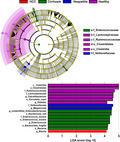- Record: found
- Abstract: found
- Article: found
Liver cirrhosis contributes to the disorder of gut microbiota in patients with hepatocellular carcinoma

Read this article at
Abstract
Background
Gut microbiota (GM) of patients with liver cancer is disordered, and syet no study reported the GM distribution of liver cirrhosis‐induced HCC (LC‐HCC) and nonliver cirrhosis‐induced HCC (NLC‐HCC). In this study, we aimed to characterize gut dysbiosis of LC‐HCC and NLC‐HCC to elucidate the role of GM in the pathogenesis of HCC.
Methods
A consecutive series of fecal samples of patients with hepatitis (24 patients), liver cirrhosis (24 patients), HCC (75 patients: 35 infected by HBV, 25 infected by HCV, and 15 with alcoholic liver disease), and healthy controls (20 patients) were obtained and sequenced on the Illumina Hiseq platform. The HCC group contains 52 LC‐HCC and 23 NLC‐HCC. Bioinformatic analysis of the intestinal microbiota was performed with QIIME and MicrobiomeAnalyst.
Results
Alpha‐diversity analysis showed that fecal microbial diversity was significantly decreased in the LC group, and there were significant differences in 3 phyla and 27 genera in the LC group vs the other groups (the healthy, hepatitis, and HCC groups). Beta‐diversity analysis showed that there were large differences between LC and the others. Gut microbial diversity was significantly increased from LC to HCC. Characterizing the fecal microbiota of LC‐HCC and NLC‐HCC, we found that microbial diversity was increased from LC to LC‐HCC rather than NLC‐HCC. Thirteen genera were discovered to be associated with the tumor size of HCC. Three biomarkers ( Enterococcus, Limnobacter, and Phyllobacterium) could be used for precision diagnosis. We also found that HBV infection, HCV infection, or ALD (alcoholic liver disease) was not associated with intestinal microbial dysbiosis in HCC.
Conclusion
Our results suggest that GM disorders are more common in patients with LC‐HCC. The butyrate‐producing genera were decreased, while genera producing‐lipopolysaccharide (LPS) were increased in LC‐HCC patients. Further studies of GM disorders may achieve early diagnosis and new therapeutic approaches for HCC patients.
Abstract
Our results suggest that butyrate‐producing genera were decreased, while LPS‐producing genera were increased in LC‐HCC patients. We demonstrated that gut microbial dysbiosis in patients with HCC is associated with LC but not HBV, HCV, or ALD. We also found that four biomarkers could be used for the precise diagnosis of HCC. This study opens an avenue to the development of novel probiotics, which might help combat the aggravation of liver diseases. Furthermore, further studies of gut microbial dysbiosis may achieve early diagnosis and new therapeutic approaches for HCC patients.
Related collections
Most cited references28

- Record: found
- Abstract: found
- Article: found
Current cancer situation in China: good or bad news from the 2018 Global Cancer Statistics?
- Record: found
- Abstract: found
- Article: not found
The gut microbiome and liver cancer: mechanisms and clinical translation
- Record: found
- Abstract: not found
- Article: not found
